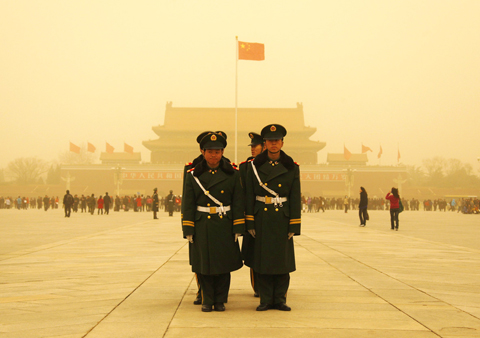Sandstorms whipped across a wide swath of China yesterday, forcing residents to don masks and scarves to protect themselves from the unhealthy grit.
It was the latest sign of the effects of desertification — overgrazing, deforestation, urban sprawl and drought have expanded deserts in the country’s north and west. The shifting sands have gradually encroached onto populated areas and worsened the sand storms that strike cities, particularly in the spring.
Winds blowing from the northwest were sweeping sand from the Xinjiang and Ningxia regions, as well as Gansu and Inner Mongolia provinces across China’s arid north. The sand and dust were even carried to parts of southern China.

PHOTO: REUTERS
The noon newscast on state television showed Hangzhou on the eastern coast, where graceful bridges and waterside pagodas were hidden in a mix of sand and other pollution.
The Central Meteorological Station urged people to close doors and windows, and cover their faces with masks or scarves when going outside. Sensitive electronic and mechanical equipment should be sealed off, the station said in a warning posted yesterday on its Web site.
China Central Television told viewers to clean out their noses with salt water and remove grit from their ears with cotton swabs dipped in alcohol.
It was the second sandstorm to hit Beijing in three days and skyscrapers in the capital were shrouded in a grayish mix of sand, dust and pollution. Residents scurried along sidewalks trying to avoid breathing in the fine particles that can cause chest discomfort and respiratory problems even in healthy people.
The US embassy in Beijing warned that particulate matter in the air made conditions “hazardous,” though high winds dispersed some of the pollution and the air quality was later upgraded to “very unhealthy.”
Duan Li (段麗), a spokeswoman for the Beijing Meteorological Station, said conditions in the city seemed more severe because a sandstorm on Saturday deposited grit on rooftops, sidewalks and trees. The winds yesterday carried in even more sand and stirred up what was already there.
Conditions were expected to improve by last night, with winds blowing the sand toward the southeast.
The worst recent sandstorm to hit Beijing was in 2006, when about 300,000 tonnes of sand was dumped on the capital.
Hong Kong’s air pollution also soared to record levels yesterday, the territory’s Environmental Protection Department said, warning that a toxic stew enveloping the region was a danger to the public.
The government agency said it found Air Pollution Index (API) readings in several cases were more than double the level at which it advises the general public to stay indoors.
“Today’s API is at record high levels,” an agency spokeswoman said in an e-mail to reporters.
Hong Kong’s famed skyline and harbor are often shrouded in a blanket of haze, which has been criticized as a public health disaster and blamed for driving some expatriates away from the international financial hub.
The API is a ratio based on the concentration of pollutants in the air, including sulfur dioxide and lead, with a higher reading indicating an increased danger to the public.
In July 2008, the territory’s environmental agency recorded air pollution levels as high as 202, well below yesterday’s record numbers which at midday ranged from a low of 192 to a record 453 reading at one roadside station.
Five other stations had readings above 400 at midday, the agency said.
“As the sandstorm from northern China is moving southward with the northeast monsoon and is now affecting Hong Kong, the API is expected to reach the ‘very high’ or ‘severe’ level,” it said in a statement.
People with heart or respiratory problems are advised to stay indoors at an API reading of more than 100. The public is advised to stay indoors or avoid prolonged exposure to heavy traffic areas when the reading is more than 200.
“This is very scary, over 300 is very scary, very polluted,” Edwin Lau (劉祉鋒), director of Friends of the Earth Hong Kong, told reporters.
Lau said the territory’s pollution problem yesterday was exacerbated by an unusual combination of the sandstorms in China and strong southerly winds, which are blowing particulates into Hong Kong.
“Hong Kong’s air pollution is bad already, but this shows we’re not dealing very well with the most severe weather situations. It is a very big alarm,” he said.
Students at Hong Kong’s Bradbury School were kept indoors yesterday.
“We have stopped any outdoor physical activity or playing to safeguard the children,” John Ainsworth, a vice principal at the school, told reporters.

With much pomp and circumstance, Cairo is today to inaugurate the long-awaited Grand Egyptian Museum (GEM), widely presented as the crowning jewel on authorities’ efforts to overhaul the country’s vital tourism industry. With a panoramic view of the Giza pyramids plateau, the museum houses thousands of artifacts spanning more than 5,000 years of Egyptian antiquity at a whopping cost of more than US$1 billion. More than two decades in the making, the ultra-modern museum anticipates 5 million visitors annually, with never-before-seen relics on display. In the run-up to the grand opening, Egyptian media and official statements have hailed the “historic moment,” describing the

‘CHILD PORNOGRAPHY’: The doll on Shein’s Web site measure about 80cm in height, and it was holding a teddy bear in a photo published by a daily newspaper France’s anti-fraud unit on Saturday said it had reported Asian e-commerce giant Shein (希音) for selling what it described as “sex dolls with a childlike appearance.” The French Directorate General for Competition, Consumer Affairs and Fraud Control (DGCCRF) said in a statement that the “description and categorization” of the items on Shein’s Web site “make it difficult to doubt the child pornography nature of the content.” Shortly after the statement, Shein announced that the dolls in question had been withdrawn from its platform and that it had launched an internal inquiry. On its Web site, Le Parisien daily published a

China’s Shenzhou-20 crewed spacecraft has delayed its return mission to Earth after the vessel was possibly hit by tiny bits of space debris, the country’s human spaceflight agency said yesterday, an unusual situation that could disrupt the operation of the country’s space station Tiangong. An impact analysis and risk assessment are underway, the China Manned Space Agency (CMSA) said in a statement, without providing a new schedule for the return mission, which was originally set to land in northern China yesterday. The delay highlights the danger to space travel posed by increasing amounts of debris, such as discarded launch vehicles or vessel

RUBBER STAMP? The latest legislative session was the most productive in the number of bills passed, but critics attributed it to a lack of dissenting voices On their last day at work, Hong Kong’s lawmakers — the first batch chosen under Beijing’s mantra of “patriots administering Hong Kong” — posed for group pictures, celebrating a job well done after four years of opposition-free politics. However, despite their smiles, about one-third of the Legislative Council will not seek another term in next month’s election, with the self-described non-establishment figure Tik Chi-yuen (狄志遠) being among those bowing out. “It used to be that [the legislature] had the benefit of free expression... Now it is more uniform. There are multiple voices, but they are not diverse enough,” Tik said, comparing it